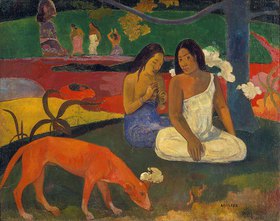Paul Gauguin - Custom-made Fine Art Prints

Paul Gauguin born 7.6.1848 in Paris - died 8.5.1903 in Atuona on Hiva Oa (Marquesas Islands)
"... of life nothing but its sweetnessße."
Gauguin was the main representative of French post-impressionist art and an early dropout from bourgeois life. He developed a style of painting and imagery that had a great influence on the "Nabis", the symbolism that Fauves had- Gauguin was an important pioneer of Expressionism. Paul Gauguin began painting in 1876 as an autodidact, made early acquaintance with Camille Pissarro, Paul Cézanne and Edgar Degas and exhibited his paintings together with them. In 1873 he married Mette-Sophie Gad, with whom he later had five children. In 1882 Paul Gauguin gave up his profession as a bank clerk and stockbroker and devoted himself exclusively to painting. At first he lived with his family in Rouen, later after the separation in Pont Aven. The Breton fishing village was a popular meeting place for artists, and the "School of Pont-Aven" was born here. On his long search for the simple, original life, he embarked for Panama in April 1887. "I am going to Panama to live like a savage," he wrote to Mette Gauguin in early April 1887. But after only one year, financial hardship forced him to return to Europe. In 1888 he worked briefly with Vincent van Gogh in Arles, but this failed due to his mental illness.
From 1891 to 1893, Gauguin lived in Haiti. He immersed himself in the myths of the Polynesians and did not want to admit the bitter reality of the supposed paradise behind the folkloric façade. He created numerous paintings with Tahitian motifs. However, they do not reflect the Tahiti that surrounded Gauguin, but the colorful, exotic world he had dreamed of. Returning to France, Gauguin suffered many strokes of fate and his "tropical paintings" brought him no success. From 1895 to 1901 Gauguin returned to Tahiti, painted and lived in seclusion in a hut. In satirical magazines he railed against the officials of the colonial administration and against missionaries. During this time, the art world in Europe gradually became aware of Gauguin's work. A contract with the important art dealer Ambroise Vollard secured him a modest but regular income. In 1901 he moved to the Marquesas Islands, as Tahiti had become too European for him. There he died at the age of 54 on 8 May 1903.
In addition to his paintings, drawings and watercolors, the artist left numerous woodcuts, ceramics and sculptures. Gauguin's painting style was characterized by Japanese woodblock prints with solidified forms, flat paint application and clear contrasts. He painted in bright colors, often without shadows in decorative and flat figure compositions. The simple, "paradisiacal" life and nature determined his choice of motifs. Gauguin did not shy away from depicting biblical themes in tropical surroundings.
In Gauguin's paintings, his dream of a paradisiacal life lives on.
Importante Recent exhibitions: Fondation Beyerle near Basel, 8. February - June 28, 2015.
Film: GAUGUIN by Edouard Deluc with Vincent Cassel, Tuhei Adams. Film release 2 November 2017. Trailer >
Text © Jürgen Banse, 2017



















































